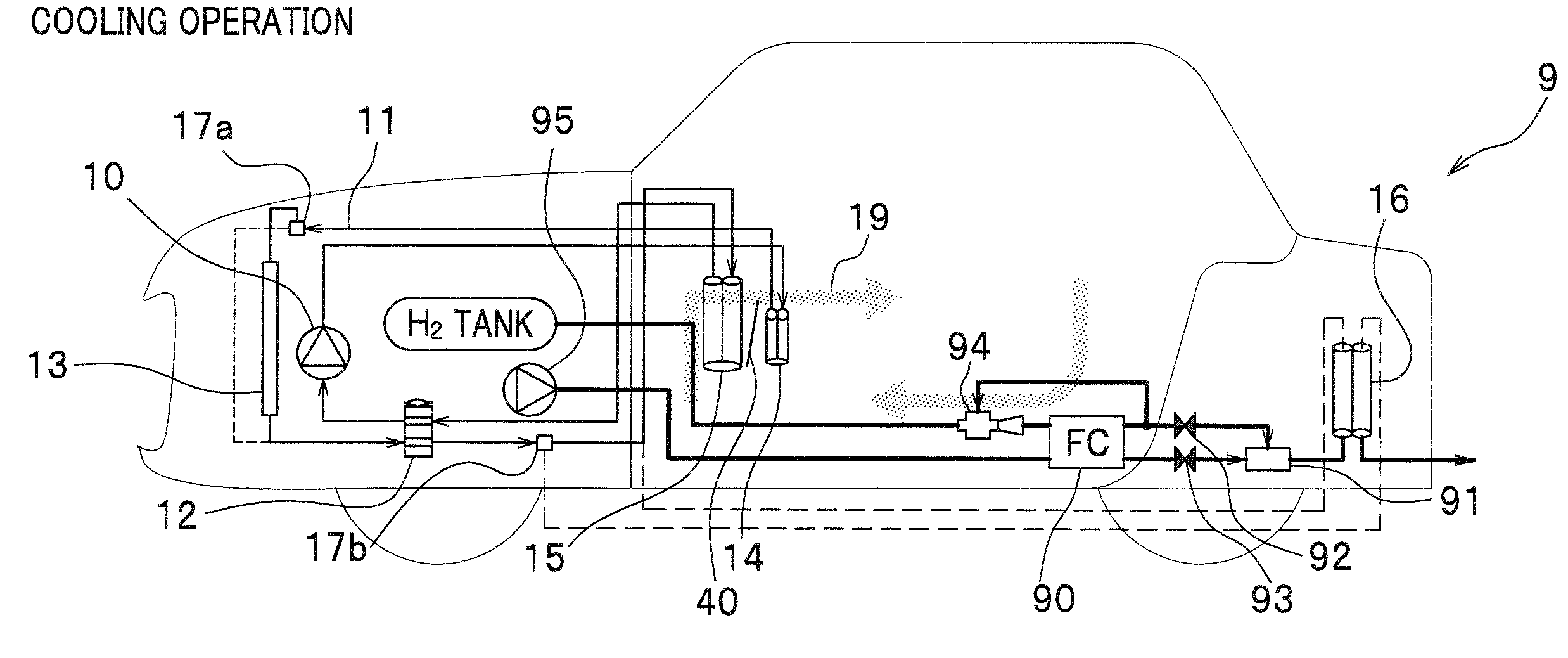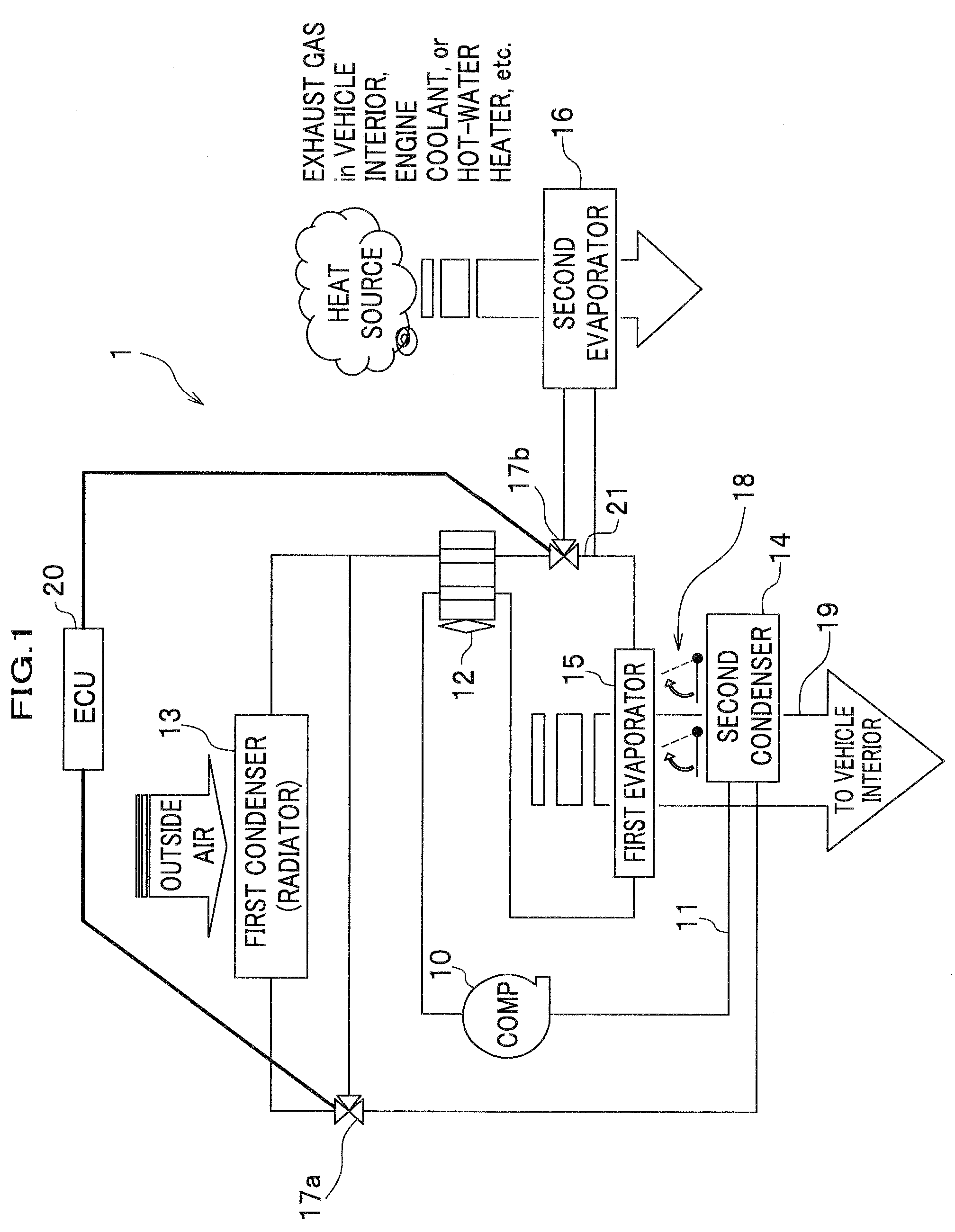Vehicle air-conditioning system
a technology of vehicle air conditioner and air conditioner, which is applied in the direction of refrigeration components, compression machines with several condensers, light and heating apparatus, etc., can solve the problems of not being able to restart operation, plurality of expansion valves require more manufacturing costs, and the plurality of expansion valves requires more manufacturing costs. , to achieve the effect of less hea
- Summary
- Abstract
- Description
- Claims
- Application Information
AI Technical Summary
Benefits of technology
Problems solved by technology
Method used
Image
Examples
first embodiment
1. Configuration of First Embodiment
[0032]First, with reference to FIG. 1, a configuration of a first embodiment of the vehicle air-conditioning system according to the present invention will be explained. FIG. 1 is a block diagram of the first embodiment of the vehicle air-conditioning system according to the present invention. Hereinafter, the first embodiment of the vehicle air-conditioning system according to the present invention will be referred to as a vehicle air-conditioning system 1.
[0033]The vehicle air-conditioning system 1 includes a compressor 10 to discharge a compressed high-pressure gas as a refrigerant; a pipe 11 to circulate the refrigerant discharged from the compressor 10; a plurality of heat exchangers (condenser, evaporator) provided at the pipe 11 to exchange heat with an air for air-conditioning; and an automated expansion valve 12 provided with the pipe 11 to expand the refrigerant. Therefore, the high-pressure gas discharged from the compressor 10 as the r...
second embodiment
3.1 Second Embodiment of Vehicle Air-Conditioning System
[0046]First, with reference to FIG. 5A and FIG. 5B, a second embodiment of the vehicle air-conditioning system according to the present invention will be explained. FIG. 5A and FIG. 5B are diagrams showing a configuration of the second embodiment of the vehicle air-conditioning system and circulation paths of the air for air-conditioning in cooling operation and heating operation. Hereinafter, the second embodiment of the vehicle air-conditioning system according to the present invention will be referred to as a vehicle air-conditioning system 5.
[0047]With reference to FIG. 5A and FIG. 5B, the vehicle air-conditioning system 5 has a configuration in which the second condenser 14 of the vehicle air-conditioning system of the first embodiment according to the present invention is replaced with a second condenser including a pump 50 to discharge a hot water, and a pipe 51 in which the hot water circulates. And, the pipe 51 has a f...
third embodiment
3.2 Third Embodiment of Vehicle Air-Conditioning System
[0055]Next, with reference to FIG. 6A and FIG. 6B, a third embodiment of the vehicle air-conditioning system according to the present invention will be explained. FIG. 6A and FIG. 6B are diagrams showing a configuration of the third embodiment of the vehicle air-conditioning system and circulation paths of the air for air-conditioning in cooling operation and heating operation. Hereinafter, the third embodiment of the vehicle air-conditioning system according to the present invention will be referred to as a vehicle air-conditioning system 6.
[0056]With reference to FIG. 6A and FIG. 6B, the vehicle air-conditioning system 6 uses an engine coolant as a heat source in heating operation. In addition, in heating operation, a heat of the engine coolant from an engine 60 is absorbed at a second evaporator 61. And, the heat of the engine coolant absorbed at the second evaporator 61 is conducted to the first evaporator 15 via the refrige...
PUM
 Login to View More
Login to View More Abstract
Description
Claims
Application Information
 Login to View More
Login to View More - R&D
- Intellectual Property
- Life Sciences
- Materials
- Tech Scout
- Unparalleled Data Quality
- Higher Quality Content
- 60% Fewer Hallucinations
Browse by: Latest US Patents, China's latest patents, Technical Efficacy Thesaurus, Application Domain, Technology Topic, Popular Technical Reports.
© 2025 PatSnap. All rights reserved.Legal|Privacy policy|Modern Slavery Act Transparency Statement|Sitemap|About US| Contact US: help@patsnap.com



